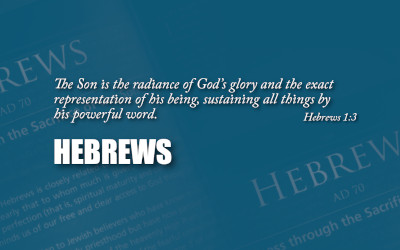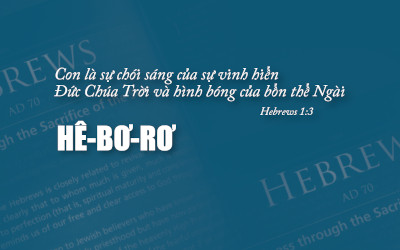Hebrews 9:1-28
The old covenant. Clear conscience. Redemption through the blood of Christ. Inheritance. Sin has been put away.
(Bấm vào đây để đọc tiếng Việt)
THE OLD COVENANT
 "THE EARTHLY HOLY PLACE
"THE EARTHLY HOLY PLACE
1Now the first covenant, in fact, had regulations for worship and its earthly sanctuary. 2For a tent was prepared, the outer one, which contained the lampstand, the table, and the presentation of the loaves; this is called the holy place. 3And after the second curtain there was a tent called the holy of holies. 4It contained the golden altar of incense and the ark of the covenant covered entirely with gold. In this ark were the golden urn containing the manna, Aaron’s rod that budded, and the stone tablets of the covenant. 5And above the ark were the cherubim of glory overshadowing the mercy seat. Now is not the time to speak of these things in detail. 6So with these things prepared like this, the priests enter continually into the outer tent as they perform their duties. 7But only the high priest enters once a year into the inner tent, and not without blood that he offers for himself and for the sins of the people committed in ignorance. (Hebrews 9:1-7)
Hebrews 9:1-7 describes the earthly tabernacle and its rituals under the Old Covenant. It details the layout of the tabernacle, including the Most Holy Place, the Holy Place, and the various furnishings. The chapter explains how the high priest would enter the Most Holy Place once a year on the Day of Atonement, bringing blood sacrifices for his sins and the sins of the people.
The rituals involving the Ark of the Covenant, the golden altar, and the golden lampstand are outlined. The passage emphasizes the symbolic nature of these rituals, pointing to the limitations of the earthly tabernacle and the need for a more perfect and eternal solution, which is ultimately fulfilled in the sacrifice of Christ in the heavenly sanctuary.
The pivotal aspect to remember in this passage is found in verse 7, highlighting the distinctive feature that sets the high priest apart from Jesus—the offering of sacrifices for both his own sins and those of the people.
CLEAR CONSCIENCE
“8The Holy Spirit is making clear that the way into the holy place had not yet appeared as long as the old tabernacle was standing. 9This was a symbol for the time then present, when gifts and sacrifices were offered that could not perfect the conscience of the worshiper. 10They served only for matters of food and drink and various ritual washings; they are external regulations imposed until the new order came.” (Hebrews 9:8-10)
Hebrews 9:8-10 underscores the limitations of the earthly tabernacle and its rituals. It states that the Holy Spirit signified the restricted access to the Most Holy Place while “the old tabernacle was standing”. The ongoing rituals and sacrifices could not perfect the conscience of the worshipers, serving only as external regulations until the time of reformation. These verses emphasize the temporary and symbolic nature of the Old Covenant rituals, pointing towards the need for a more profound and lasting solution in Christ’s sacrifice under the New Covenant.
In numerous ways, contemporary Christians continue to lead their lives as if the old tabernacle persists, offering diverse sacrifices that are incapable of removing their sins.
REDEMPTION THROUGH THE BLOOD OF CHRIST
“11But now Christ has come as the high priest of the good things to come. He passed through the greater and more perfect tent not made with hands, that is, not of this creation, 12and he entered once for all into the most holy place not by the blood of goats and calves but by his own blood, and so he himself secured eternal redemption. 13For if the blood of goats and bulls and the ashes of a young cow sprinkled on those who are defiled consecrated them and provided ritual purity, 14how much more will the blood of Christ, who through the eternal Spirit offered himself without blemish to God, purify our consciences from dead works to worship the living God.” (Hebrews 9:11-14)
Hebrews 9:11-14 underscores the superior and transformative quality of Christ’s sacrifice when compared to the rituals of the Old Covenant. The passage emphasizes the effectiveness of Christ’s blood in contrast to the blood of bulls and goats, which cannot remove sins.
Should someone attempt to reconcile for their sins, they would, under no circumstances, gain entry to the heavenly tent established by God, where Christ is presently presenting his own blood. If Christ’s sacrifice is fully capable of removing your sins, why engage in additional efforts beyond what he accomplishes?
INHERITANCE
“15And so he is the mediator of a new covenant, so that those who are called may receive the eternal inheritance he has promised, since he died to set them free from the violations committed under the first covenant. 16For where there is a will, the death of the one who made it must be proven. 17For a will takes effect only at death, since it carries no force while the one who made it is alive.” (Hebrews 9:15-17)
Numerous Christians seek to discern God’s will for their lives, wondering about choices like marriage, career, or relocation. However, His ultimate will for you is an eternal inheritance, already secured through Christ’s sacrifice.
SIN HAS BEEN PUT AWAY
“18So even the first covenant was inaugurated with blood. 19For when Moses had spoken every command to all the people according to the law, he took the blood of calves and goats with water and scarlet wool and hyssop and sprinkled both the book itself and all the people, 20and said, “This is the blood of the covenant that God has commanded you to keep.” 21And both the tabernacle and all the utensils of worship he likewise sprinkled with blood. 22Indeed according to the law almost everything was purified with blood, and without the shedding of blood there is no forgiveness. 23So it was necessary for the sketches of the things in heaven to be purified with these sacrifices, but the heavenly things themselves required better sacrifices than these. 24For Christ did not enter a sanctuary made with hands – the representation of the true sanctuary – but into heaven itself, and he appears now in God’s presence for us. 25And he did not enter to offer himself again and again, the way the high priest enters the sanctuary year after year with blood that is not his own, 26for then he would have had to suffer again and again since the foundation of the world. But now he has appeared once for all at the consummation of the ages to put away sin by his sacrifice. 27And just as people are appointed to die once, and then to face judgment, 28so also, after Christ was offered once to bear the sins of many, to those who eagerly await him he will appear a second time, not to bear sin but to bring salvation. “ (Hebrews 9:18-28)
Hebrews 9:18-28 explains the significance of Christ’s sacrifice in contrast to the Old Covenant rituals. It underscores the necessity for blood to be shed for the forgiveness of sins and emphasizes that Christ’s death serves as the ultimate atonement, surpassing the temporary and symbolic nature of the Old Covenant sacrifices. The passage highlights the once-for-all nature of Christ’s sacrifice, contrasting it with the repeated offerings under the Old Covenant. It concludes by emphasizing that Christ will appear a second time, not to deal with sin, but to bring salvation to those who eagerly await Him.
In the majority of world religions, including Christianity, addressing sins constitutes a primary and central emphasis. Nevertheless, as indicated in this passage, the matter of sin has been conclusively addressed once and for all. God granted people ample time to demonstrate that the issue of sin could not be resolved, and now He has provided a definitive, all-encompassing solution effective in eradicating sins. This doesn’t imply that individuals are incapable of sinning, but rather that they no longer need to be preoccupied with perpetually addressing sins while still residing in the physical realm.
Nghi Nguyen
- Scripture quoted by permission. All scripture quotations, unless otherwise indicated, are taken from the NET Bible® copyright ©1996-2006 by Biblical Studies Press, L.L.C. All rights reserved.
Disclaimer: This is my own opinion on the topic, which does not necessarily reflect the church's theology, or beliefs of the individuals in it — Nghi Nguyen
